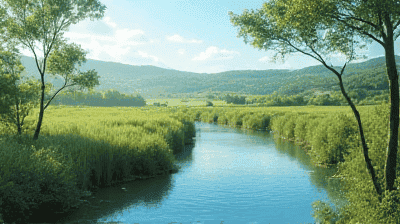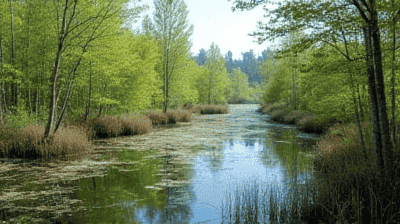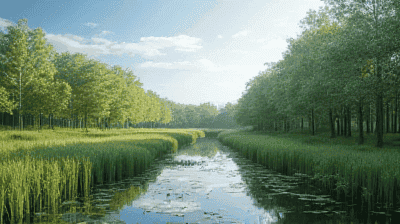
Wetlands, often described as the earth's kidneys, play a critical role in maintaining ecological balance and supporting biodiversity. These unique ecosystems, which include marshes, swamps, and peatlands, are vital for climate change mitigation and adaptation. As the world grapples with the escalating impacts of climate change, understanding the functions and benefits of wetlands—particularly their capacity for carbon sequestration and flood control—becomes increasingly important.
Wetlands are areas where water is either at or near the surface of the soil for part of the year. They can occur in various forms, including coastal wetlands (such as salt marshes and mangroves), freshwater wetlands (such as marshes, swamps, and fens), and artificial wetlands (such as constructed wetlands). Wetlands are characterized by their unique hydrology, soil types, and vegetation, which include various grasses, shrubs, and trees adapted to wet conditions.
Marshes: Dominated by herbaceous plants (grasses, sedges, and reeds), marshes can be freshwater or saltwater. They are often found along the edges of lakes, rivers, and coastal areas.
Swamps: These wetlands are dominated by woody plants such as trees and shrubs. Swamps can be further classified into freshwater swamps and saltwater swamps, depending on the salinity of the water.
Bogs: Bogs are a type of peatland that accumulates peat, made up of partially decayed plant material. They are typically acidic and nutrient-poor, supporting unique vegetation adapted to such conditions.
Fens: Fens are another type of peatland, but unlike bogs, they receive nutrients from groundwater. They support a diverse array of plant species.
Mangroves: These coastal wetlands are found in tropical and subtropical regions and are characterized by salt-tolerant trees that play an essential role in coastal protection.

Carbon sequestration refers to the process of capturing and storing atmospheric carbon dioxide (CO2) to mitigate climate change. This can occur naturally through processes in ecosystems or through human-engineered technologies. Wetlands are among the most effective natural carbon sinks, with the ability to store carbon in both plant biomass and soil.
Vegetation Growth: Wetland plants absorb CO2 during photosynthesis and store it in their biomass. When these plants die, the carbon is stored in the soil rather than being released back into the atmosphere.
Soil Accumulation: Wetlands often develop waterlogged conditions that slow down the decomposition of organic matter. This anaerobic environment allows for the accumulation of peat and other organic materials, effectively trapping carbon in the soil over long periods.
Methane Emissions: While wetlands generally act as carbon sinks, they can also produce methane, a potent greenhouse gas. However, the net carbon benefit of wetlands is typically positive due to the significant amount of carbon they sequester in comparison to the methane released.
Peatlands, a specific type of wetland, are particularly noteworthy for their carbon sequestration capabilities. Although they cover only about 3% of the Earth's land surface, they store approximately one-third of the world's soil carbon. This makes peatlands critical in the global carbon cycle and a focal point for climate change mitigation efforts.
Wetlands face numerous threats that can compromise their ability to sequester carbon effectively:
Drainage and Conversion: The draining of wetlands for agriculture, urban development, and infrastructure projects releases stored carbon back into the atmosphere, contributing to climate change.
Climate Change Effects: Changing climate conditions, such as alterations in precipitation patterns and temperature, can affect wetland hydrology and plant communities, potentially reducing their carbon storage capacity.
Pollution: Nutrient loading from agricultural runoff can lead to eutrophication, which can alter plant communities and reduce the effectiveness of wetlands as carbon sinks.
Flood control involves strategies and practices aimed at managing excess water to minimize the impacts of flooding on human populations and ecosystems. Wetlands play a critical role in flood management due to their natural ability to absorb and store water during heavy rainfall events.
Water Retention: Wetlands act like sponges, retaining excess rainwater and slowly releasing it over time. This helps to mitigate the severity of flooding downstream.
Reduced Runoff: The vegetation in wetlands slows down surface runoff, allowing water to infiltrate the soil rather than swiftly flowing into rivers and streams, which can reduce flood peaks.
Natural Barriers: Coastal wetlands, such as mangroves and salt marshes, provide protection against storm surges and rising sea levels by acting as buffers that absorb wave energy.
Everglades Restoration: The restoration of the Everglades in Florida not only enhances biodiversity but also improves flood control by restoring natural water flow patterns. This has helped protect surrounding communities from flooding.
Bangladesh Wetland Management: Flood-prone regions in Bangladesh have implemented wetland conservation strategies to enhance flood resilience. By restoring and maintaining wetlands, local communities have improved their capacity to manage floodwaters and protect agricultural lands.
Hurricane Sandy and Coastal Wetlands: Following Hurricane Sandy, the role of coastal wetlands in reducing storm impacts gained significant attention. Studies demonstrated that healthy wetland ecosystems lessened the storm's impact on coastal communities by providing natural barriers against flooding.

Wetlands provide a range of ecosystem services that contribute to human well-being and economic stability:
Water Quality Improvement: Wetlands filter pollutants and excess nutrients from water, enhancing water quality for downstream users, including drinking water supplies.
Biodiversity Support: Wetlands are home to diverse species of plants and animals, many of which are crucial for maintaining ecological balance and supporting fisheries.
Recreation and Tourism: Healthy wetland ecosystems offer recreational opportunities such as birdwatching, fishing, and ecotourism, generating economic benefits for local communities.
Climate Regulation: By sequestering carbon and regulating local climate conditions, wetlands contribute to the overall mitigation of climate change impacts.
Quantifying the economic value of wetlands can help in decision-making and allocating resources for conservation. Various studies have shown that the ecosystem services provided by wetlands can result in significant economic benefits, often outweighing the costs associated with their conservation. For example, a study on the value of coastal wetlands in the United States estimated that these ecosystems provide services worth billions of dollars annually, including flood control and water filtration.
Conservation of existing wetlands is crucial for maintaining their ecological functions. Strategies may include:
Legal Protection: Enacting laws and regulations to protect wetlands from development, pollution, and other threats.
Buffer Zones: Establishing buffer zones around wetland areas can help reduce the impacts of adjacent land use and improve water quality.
Public Awareness Campaigns: Educating communities about the importance of wetlands can foster a culture of conservation and encourage local stewardship.
Restoration projects can reinstate the ecological functions of degraded wetlands. Effective restoration strategies may include:
Reestablishing Hydrology: Restoring natural water flow patterns can help rehabilitate wetlands and improve their ecological health.
Vegetation Management: Replanting native vegetation and controlling invasive species can accelerate ecosystem recovery and enhance biodiversity.
Monitoring and Adaptive Management: Implementing monitoring programs allows for ongoing assessment of restoration efforts and adaptive management to ensure long-term success.
Wetland conservation and restoration should be incorporated into broader climate action plans. This holistic approach recognizes the value of wetlands in achieving climate goals and enhances resilience to climate impacts.
Empowering local communities to participate in wetland management can lead to more effective conservation efforts. This includes providing training, resources, and support for community-led initiatives focused on wetland preservation and restoration.

Wetlands are recognized for their global significance, leading to various international agreements focused on their conservation:
Ramsar Convention: The Ramsar Convention on Wetlands is an international treaty aimed at the conservation and sustainable use of wetlands. It promotes the designation of Wetlands of International Importance and encourages countries to develop conservation strategies.
United Nations Sustainable Development Goals (SDGs): Wetlands play a vital role in achieving several SDGs, including Goal 13 (Climate Action), Goal 14 (Life Below Water), and Goal 15 (Life on Land). Their preservation contributes to healthy ecosystems and climate resilience.
Despite their importance, wetlands around the world face alarming rates of degradation and loss. According to various studies, approximately 50% of the world's wetlands have been lost since the 1900s, primarily due to human activities such as land conversion, drainage, and pollution. This loss poses significant risks to biodiversity, water security, and climate stability.
Wetlands are essential ecosystems that provide critical services for climate mitigation and adaptation. Their role as carbon sinks enables the sequestration of significant amounts of greenhouse gases, helping to combat climate change. Additionally, wetlands play a vital role in flood control, protecting communities and infrastructure from the impacts of extreme weather events.
As the world confronts the realities of climate change, it is imperative that we prioritize the conservation and restoration of wetlands. Implementing effective management strategies, engaging local communities, and recognizing the economic value of wetlands can facilitate sustainable practices that benefit both people and the planet.
By embracing the intrinsic value of wetlands and their contributions to climate resilience, we can work toward a more sustainable future that ensures the well-being of both current and future generations.